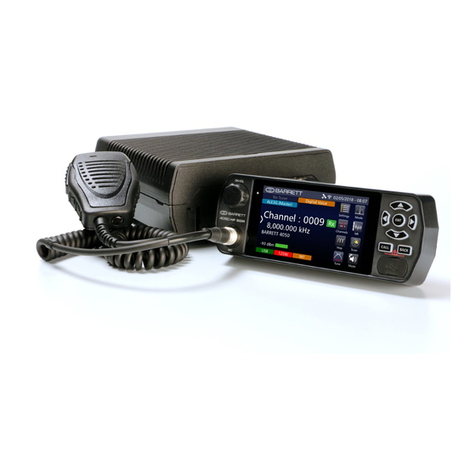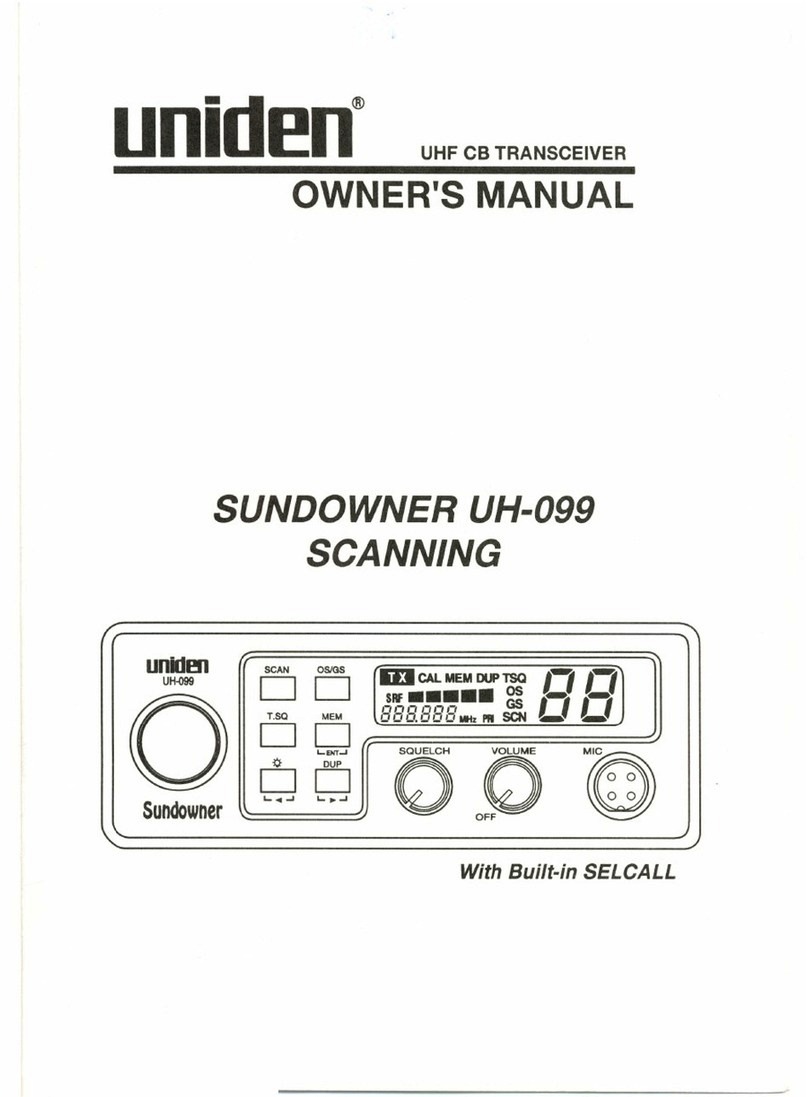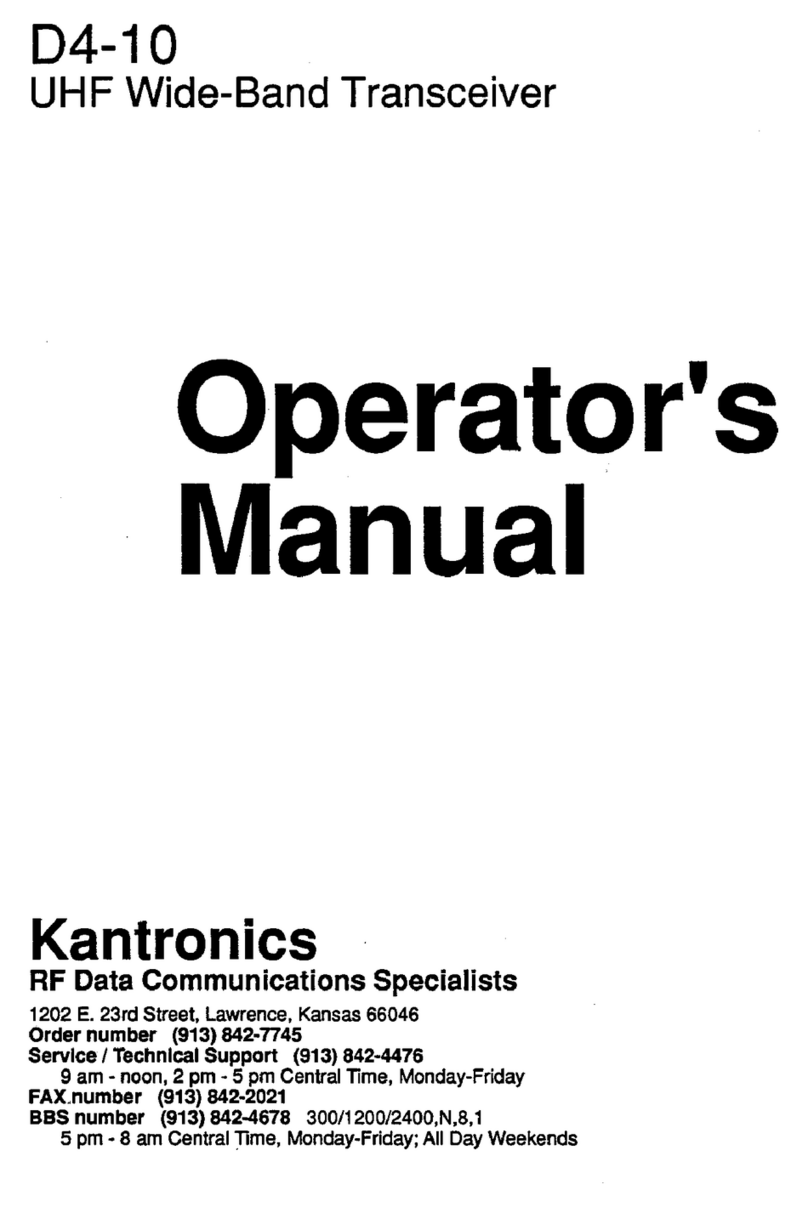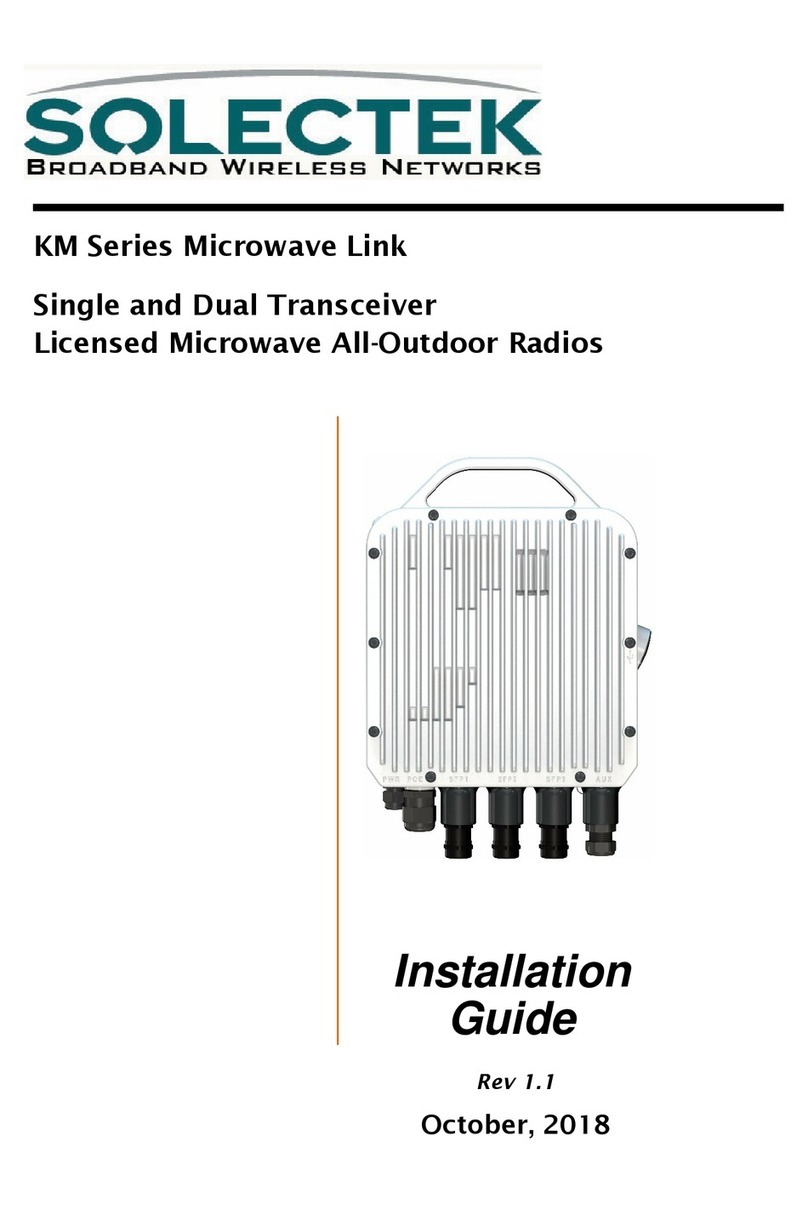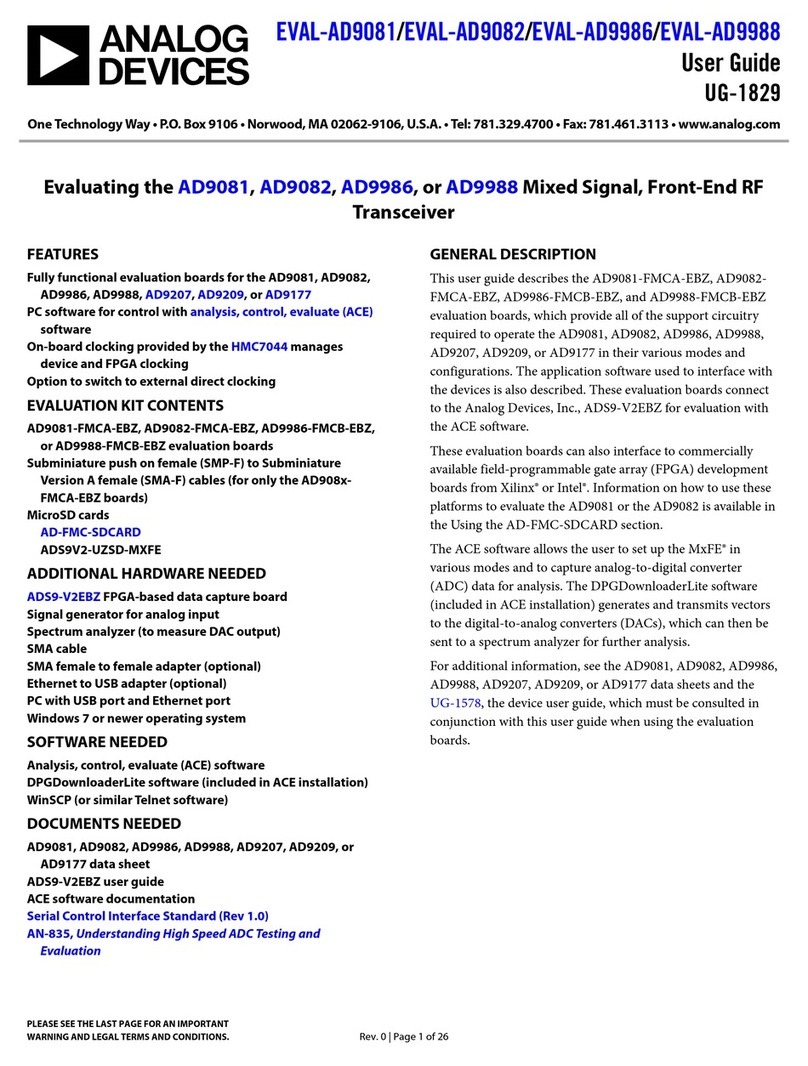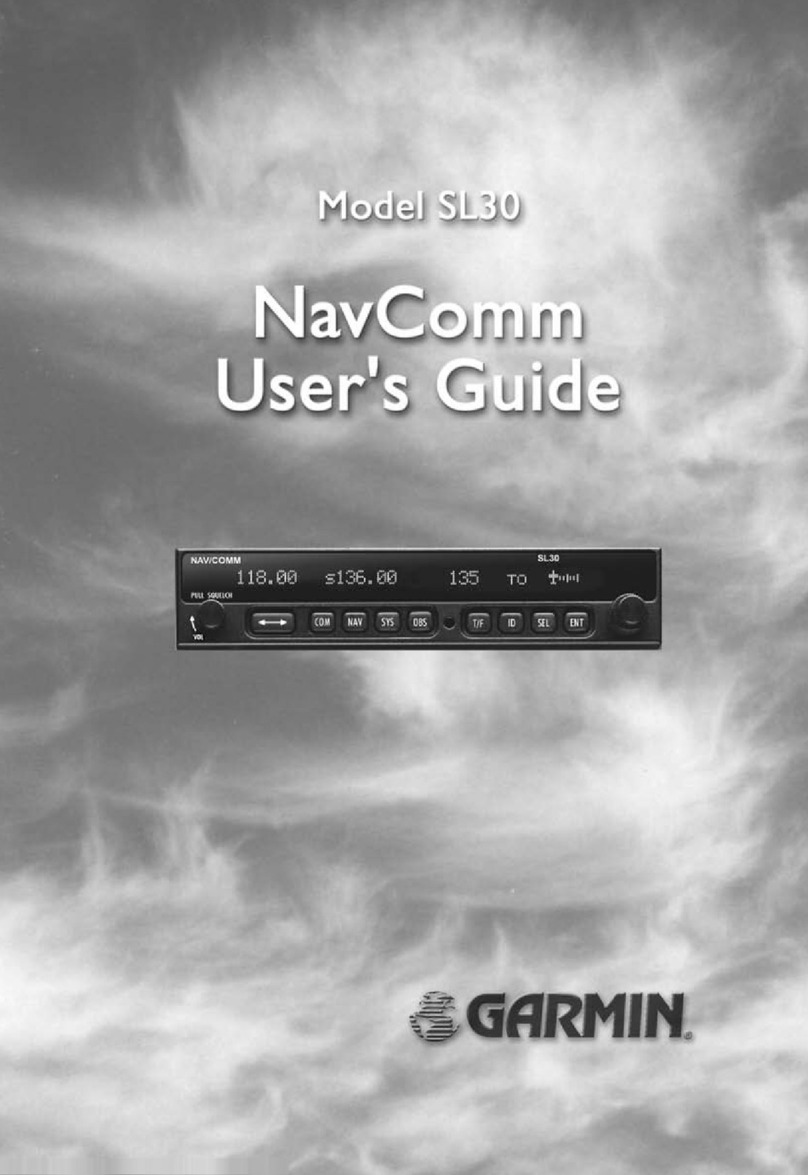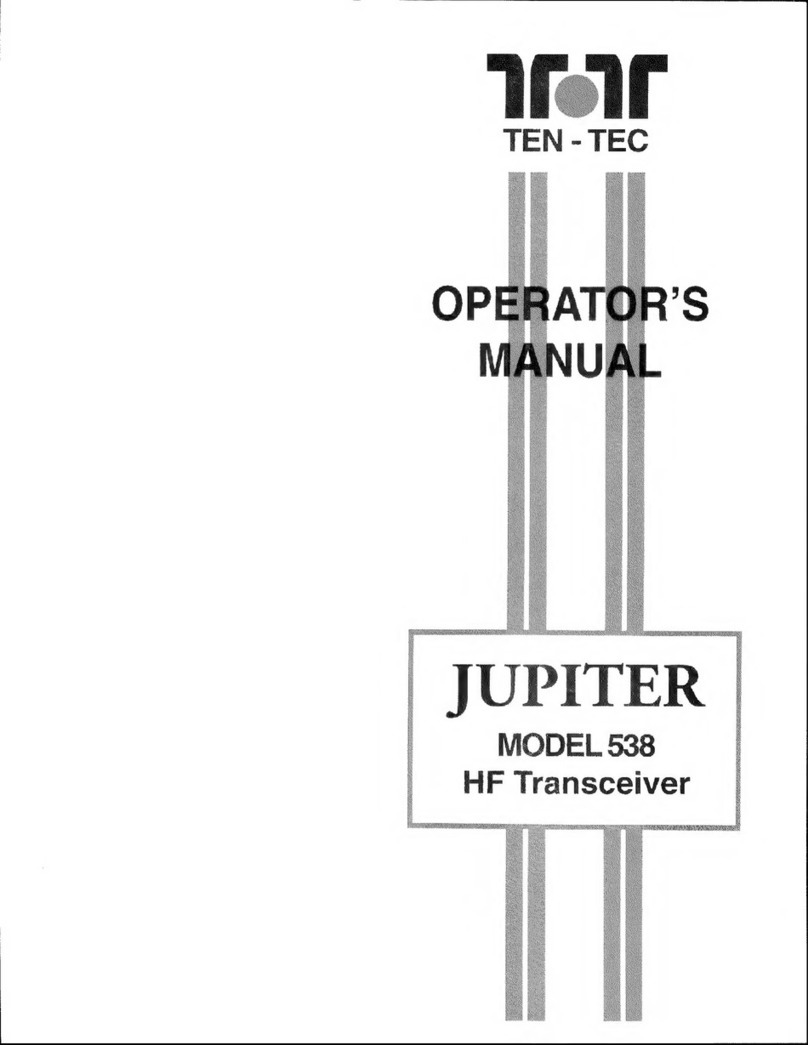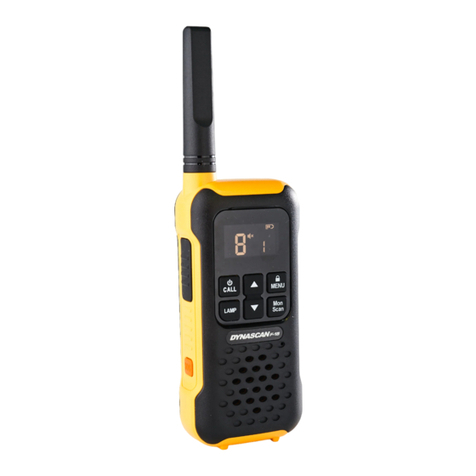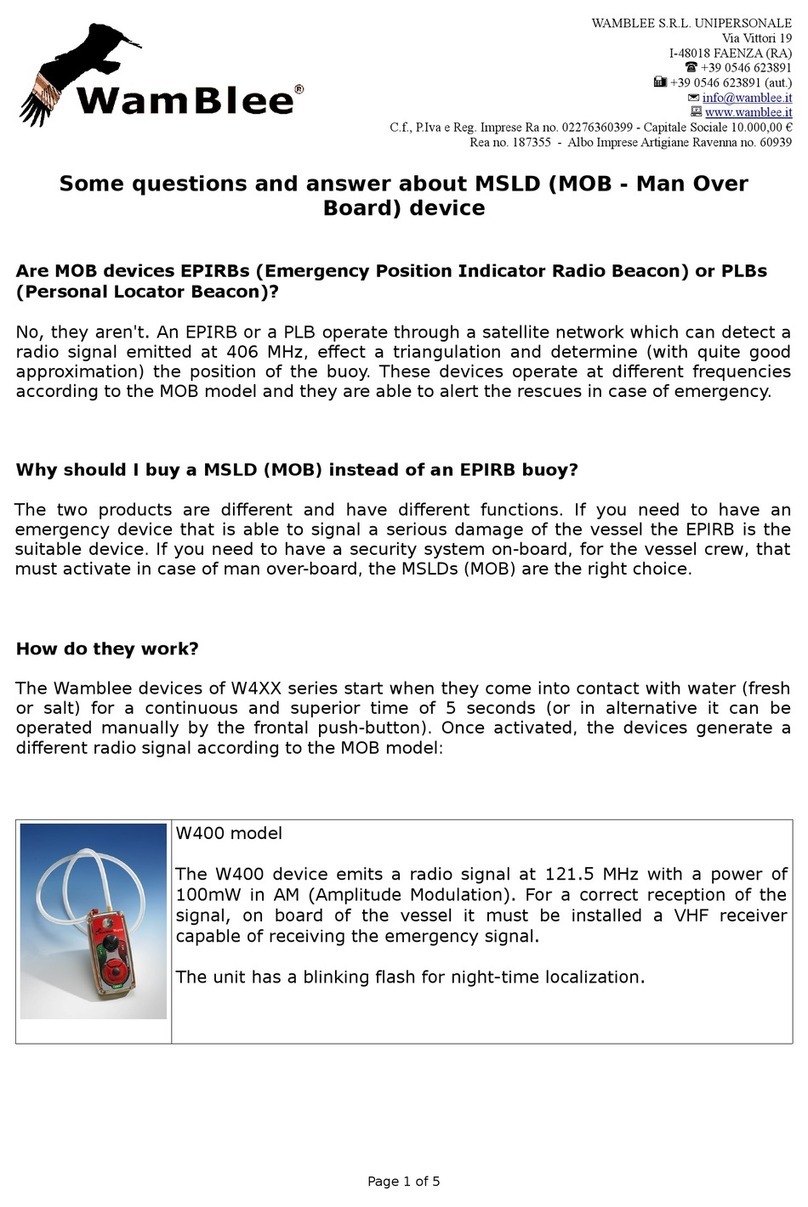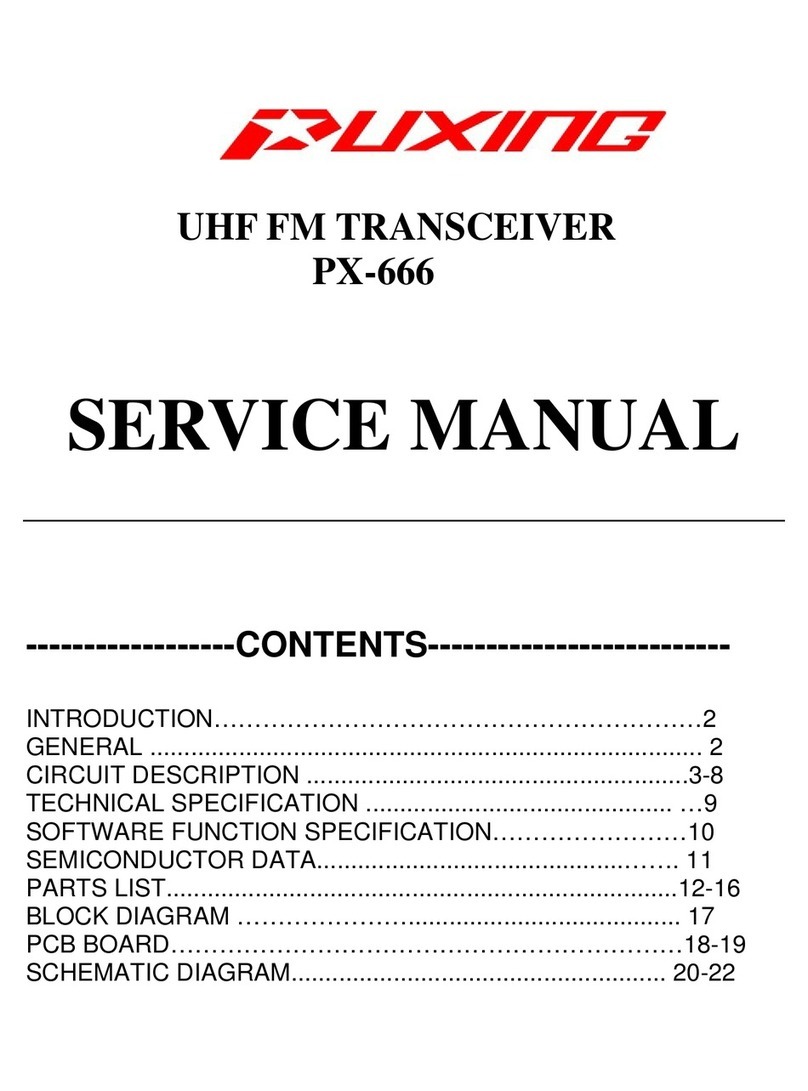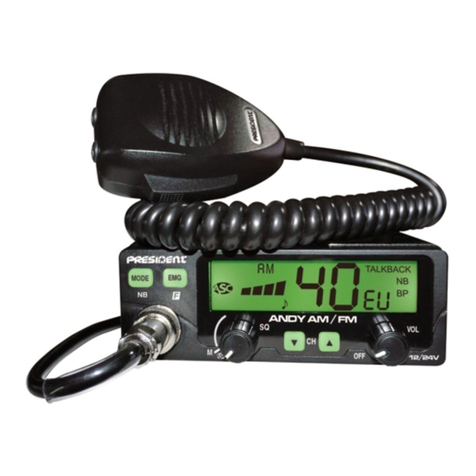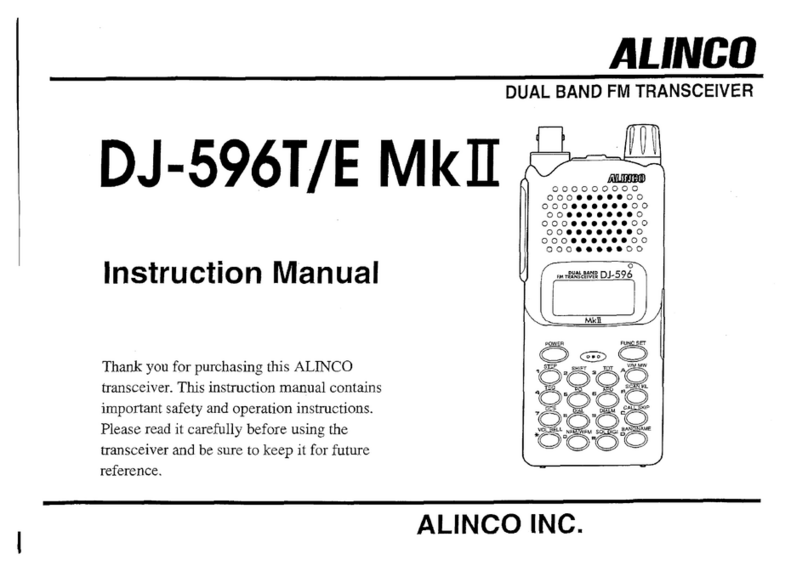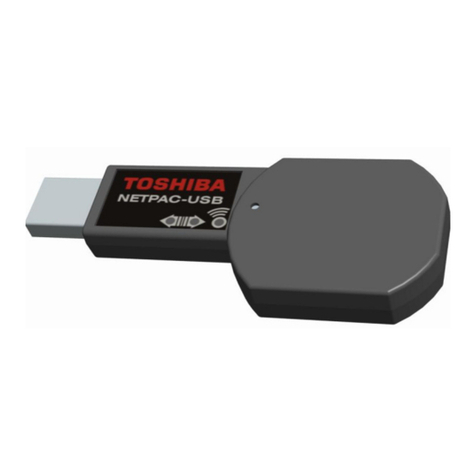Small Wonder Labs DSW-II-80 User manual

DSW-II-80 Transceiver kit -Instructions D. Benson, K1SWL 02/12/04 p. 1
S
S
Sm
m
ma
a
al
l
ll
l
l
W
W
Wo
o
on
n
nd
d
de
e
er
r
r
L
L
La
a
ab
b
bs
s
s
The DSW-II-80
Transceiver Kit
Welcome! The DSW-II manual departs from the traditional Small Wonder Labs instructions. These pages contain the
information necessary for a reasonably-experienced builder to complete this kit successfully. If you're new to kit-
building, please go on-line and check out:
http://smallwonderlabs.com/DSWhelps.pdf
That URL contains a Supplement document (in .pdf format) with component identification tips, technical description,
basic soldering instruction and troubleshooting information. Why this approach? You've seen most of this information
in my earlier manuals- print only the portion you need and save a tree!
This document itself is kept current at http://smallwonderlabs.com/DSW80_Manual.pdf
Table of Contents:
Description Page
Parts list 2-3
Schematic- Transmitter/Local Oscillator 4
Schematic- Receiver 5
Pictorial Drawing 6
Assembly Instructions 7-9
Alignment 11
Operating the DSW-II 12
Addendum 13

DSW-II-80 Transceiver kit -Instructions D. Benson, K1SWL 02/12/04 p. 2
The 'DSW-II-80'
Parts list
(quantities in blue are those items pre-installed by Small Wonder Labs)
Qty. Ref. Designator Component Description
1 C4 10 pF NPO disk cap '10'
1 C26 15 pF NPO disk cap '15'
2 (2) C22,C23 22 pF NPO disk cap '22', Pre-installed
1 C17 27 pF NPO disk cap '27' or '27J'
1 C5 47 pF NPO disk cap '47' or '47J'
2 C24,C27 47 pF NPO monolithic cap '470'
1 C25 100 pF NPO monolithic cap '101' or '101J'
1 C12 15-70 pF trimmer cap Brown
1 C1 120 pF disk cap '121' or '121J'
8 C6-C11, C16, C104 150 pF disk cap '151' or '151J'
1 C2 330 pF disk cap '331' or '331J'
1 C35 560 pF NPO monolithic cap '561' or '561J'
1 C19 820 pF poly cap '821' or 821J'
1 C34 1200 pF NPO monolithic cap '122' or '122J'
1 C32 1500 pF NPO monolithic cap '152' or 152J'
1 C33 2200 pF NPO monolithic cap '222' or '222J'
1 C20 2200 pF (.0022 uF) poly cap '222' or '222J'
14 C3,C15,C28-30,C101-102,
C108-111,C118,121,122 .01 uF disk cap '103', ceramic
2 (2) C114,C115 .01 uF 0805 SMT cap Pre-installed
2 C14,C18 .033 uF poly cap 333' or '333K'
7 (1) C13,C31,C103,C106,
C107,116,C120 .1 uF monolithic cap '104', epoxy case
2 (2) C112,C113 .1 uF 1206 SMT cap Pre-installed
1 C117 10 uF electrolytic cap
2 C21,C105 47 uF electrolytic cap
1 C119 220 uF electrolytic cap
7 D1-D6,D8 1N4148 diode glass body
1 D7 1N5818 diode
1 D9 1N4751A diode
1 HS1 TO-220 heat sink Black-anodized w/fins
1 - - #4-40 x 1/4" machine screw
1 - - #4-40 nut
2 J1,J4 3.5mm stereo conn, PC-mount w/ knurled nut
1 J2 DC power jack, 2.1/5.5mm
1 J3 BNC conn., PC-mount w/ nut, lock washer
1 J5 10-pin header strip
1 L1 16 uH- 31 turns #26 on T44-15 Red/white toroid
1 L2 10 uH RF choke Brown-blk-black
1 L3 22 uH RF choke Red-red-black
1 L4 5.6 uH SMT Inductor
1 L5 4.7 uH SMT Inductor
1 L6 3.3 uH SMT Inductor SWL ref: / DN1118
1 L7 FT37-61 toroid, 14 turns #24 dark grey toroid
1 L8 T37-2, wind w/ 18 turns #26 red toroid
2 L9, L10 T37-2, wind w/ 25 turns #26 red toroid
1 P1 2.1 mm/5.5mm power plug
1 - - 2' (0.7m) power wire

DSW-II-80 Transceiver kit -Instructions D. Benson, K1SWL 02/12/04 p. 3
2 R7, R14 10 ohm, 1/4W 5% resistor Brown-blk-blk
2 R2,R22 51 ohm, 1/4W 5% resistor Green-brwn-blk
1 R26 100 ohm, " " " Brown-blk-brown
1 (1) R17 240 ohm , pre-installed Red-yellow-brown
3 R1,R18, R23 470 ohm, 1/4W 5% resistor Yellow-violet-brn
1 R19 500 ohm trim pot Blue plastic, 3 leads
1 (1) R16 3.9K ohm, SMT res., 0805 pre-installed
6 R3,R4,R15,R20-21, R25 10K ohm, 1/4W 5% resistor Brown-blk-orange
2 R10,R24 22K ohm " " " Red-red-orange
3 R5,R6,R11 510K ohm " " " Green-brn-yellow
3 R8,R12,R13 1M ohm " " " Brown-blk-green
1 R9 4.7 M resistor Yellow-violet-green
1 T1 IF Transformer '43IF123'
1 Q1 2N5485 or 2N5486 transistor (TO-92 package)
2 Q2,Q3 2N7000 transistor (TO-92 package)
1 Q4 2N3906 transistor (TO-92 package)
1 Q5 2SC1971 transistor TO-220 package
2 U1,U2 SA602AN or SA612AN IC 8-pin DIP IC
1 U3 TS922 IC, Audio Amplifier 8-pin DIP IC
1 (1) U4 78L05A pre-installed
1 (1) U5 25.000 Mhz Oscillator pre-installed
1 (1) U6 AD9835BRU, DDS IC pre-installed
1 (1) U7 PIC16C622A microcontroller,
preprogrammed pre-installed
1 U8 LT1252 IC, video driver IC 8-pin DIP IC
1 U9 78L06A TO-92 package
4 Y1-Y4 5.185 Mhz crystal, series-res matched set, '5.18-S'
1 (1) Y5 4.096 Mhz crystal, 20 pF pre-installed
4 - - 8-pin IC socket
1 (1) - - 18-pin IC socket pre-installed
1 12" (30 cm) #24 magnet wire
1 6' (1.9m) #26 magnet wire
1 - - Printed circuit board 'SWL 11/24/03'
1 - - Enclosure, w/ 2-bezels,
4- black-anodized screws
1 - - Front panel
1 - - Rear panel
1 - - Small knob
1 - - Medium knob
Notes: 1) Items with gray-shaded quantities are in an anti-static envelope.
Front-Panel Daughterboard
2 C1,C2 .01 uF disk cap '103' or '103M'
1 POT 5K ohm, 9mm PC-mount / DK P3C3502
1 S1 Subminiature pushbutton sw. / w/ nut, lockwasher
1 S2 Subminiature. toggle sw. / DK CKN1088
1 S3 Shaft encoder, rotary 3 leads, w/ nut, washer
1 - - Printed circuit board
1 LED Yellow LED
1 W1 Flex cable / DK A9BAG-1002F
3 R1-R3 1.5K ohm, 1/4W 5% resistor Brown-green-red

DSW-II-80 Transceiver kit -Instructions D. Benson, K1SWL 02/12/04 p. 4
DSW-II-80 Schematic, p. 1 of 2
D. Benson, K1SWL 02/07/2004
J1
J2
J3
V+
14
2
3
.01*
AD9835
1
3.9K* 5,11,
12,13
B
C
D
E
SCLK
SDATA
FSYNC
MUTE/
FSEL
7
8
9
10
4
5
6
VR1
4V
OUT
V+
IN
8
G10K
22K
220 uF
415 16
3
2
7
6
4
16 15
22 22
Y5 5
D
E
F
G
RB3
RB2
RA3
RA2
MUTE/FSEL
Sidetone
TX Key
FSYNC
9
8
2
1
B
C
SDATA
SCLK
18
17
RA1
RA0
'DOT'
'DASH' RB5
RB4
11
10
p/o J5
RIT SW RA4
3
VR1
10K
6
'KEYER' RB0
.1
12 RB6
STEP SIZE 13 RB7
RB1
7
Ph. A TUNE
Ph. B TUNE
H
414
.01
100 30V A
500
.01
10K
10K
LT1252
78
L04
.01
51 470
6
5
4
8
9
p/o J5
RIT INDICATOR
7
10 GND
(DAUGHTERBOARD)
10 uF
.1
.01
R1
RIT
Ph. A TUNE
Ph. B TUNE
4
8
9
10
S2
S3
(GRN)
R2
C1/C2
1
2
3
R1-R3: 1.5K ohm
.01 (2 pl.)
R3
7
STEP SIZE 6
(UP)
1
2
3
GAIN
POT
GND
RIT
INDICATOR
(n/o)
S1
5
KEYER
U7
U4
U5
U6 U8
C107
*
C108
C109
C110 C111
R15
C22 C23
C112
C113 C114
C115
.01*
.1*
.1*
C24 C25
C26
C27
C28
C29
C30 C31
C33 C34
L4
L5
L6
L7 L8 L9
R16
R17 R18
R19
R20
R21
R22
R23
R24
R25
R26
Q5
C119
C120
.1
.1
D7
D8 D9
Q4
Q3
C116
C117
C118
.01
.01
.01 .01
240 470
5.6
4.7
47 100 47
15 3.3 uH
L10
C35
560
2200 1200
T37-2
25 turns
T37-2
18 turns T37-2
25 turns
25 Mhz
P5
ANT.
C32
*
*
* *
*
*
**
indicates factory-installed part
*
16C
622A
2N7000 2N3906
2SC1971
1500

DSW-II-80 Transceiver kit -Instructions D. Benson, K1SWL 02/12/04 p. 5
D. Benson, K1SWL 2/11/2004
DSW-II-80 Schematic, p. 2 of 2
47 uF
3
28
1
4
6
57
A
2
p/o J5
U1
1
2
3
85
6
.01
.01
U2
1
2
3
85
6
.01
4
5V
V+
U3-A
U3-B
H
5V E
F
5V
4.8V
4.8V
7
47 uF
3
C1
1
L1
C2
T1*
* Internal
cap left intact
D1
D2 D3
D4
C101
C3
C4
C5
L2
C6 C7 C8
C9
L3 Y1 Y2 Y3
R1
C102
.01
C103
R2
C10
C11
Y4
C12
C13
C14
C15
C104
C105
C16
D5
D6
R3
R4
R6
R7
R5
C17
C18
C19
C20
C106
R8
R9
R10
R11
R12
R14
C21
R13
J4
AF OUT
Q1
Q2
120 16 uH 10 uH
10
330
47
Y1-Y3: 5.185 Mhz
51
470 .033 .1
.01
150 (2pl)
15-70
10K
10K
510K
510K
10
1M
.033
150
27
4.7M
2N7000
22K
1M
820
510K
1M .1
10
.0022
150
150 150 150
150
22 uH
C121
.01
OUT
V+
IN 78
L06
U9
5V
C122
.01
SA602
SA602
TS922
2N
5486

DSW-II-80 Transceiver kit -Instructions D. Benson, K1SWL 02/12/04 p. 6
J2
J3
L9
L8
J4
L10
L7
D9
J1
T1
U1 U2
U3
SA602 SA602 TS922
Y1
Y2 Y3
5.185
5.185
5.185
5.185
C12
Y4
C8
150
U5
U7
R15 10K
R19
R18
470
- +
- +
C35
560
100
C25
- +
C120
.1
R13
1M C105
47 uF
R5
510K
L5
L4
L6
3.3 uH
5.6
J5
4.7
Q3
2N7000
Y5
4.096
C23
C22
22
22
.1
C116
Q4
10K
R20
R25
10K
C117
10 uF
C119
220
uF
C118
.01
C2 C17
330 27 C5 C6
47 150
78L05
C106
.
1
Q1
Q2
.01
.01
C111
C110
2N7000
2N5485/
2N5486
U8
LT1252
C102
.01
R1470
C9
150
C103
.1
C101
.01 L3
22 uH
.1
.01
.
033
C15
C13
C14
L1
L2
C4
C3 .01
C109
C108 .01
.01
10 150
C7
PIC16C622A-04/P
C107
.
1R17
240
25.000M
U4
C114
.01
R16
3.9K
.01
C115
C113
.
1
.
1
C112
C24 47
C27
47
15
C26
U6
C28
.01
R21
10K
D7
R2422K
AD
9835
.1
C31
Q5
C104
150
10K
10K
R3
R4
R2 51
C16
150
C1
120
C32
C121
.
01
C33
2200
C34
1200
510K
R6
D5
D6
C11
150 150
C10
C18
.
033
R7
10 1M
R12
820
2200
C19
C20
U9
R23
R22 470
51
C29
C30
.
01
.
01
.
01
C122 D1D2D3D4
D8
R26 100
510K 22K
R11 R10
2N3906
1M
R8
R9
4
.
7M
- +
C21
47 uF
R14
10
Note: Components with green dots are pre-installed by Small Wonder Labs.
DSW-II-80
- Pictorial
Dave Benson, K1SWL
as of 2/11/2004
-Keyer-
3.5mm
Stereo
-AF OUT-
3.5mm
Stereo
-ANT.-
BNC
-PWR.-
2.1 mm/
5.5 mm
-Drive-
( pot )
78L06
10uH
1500

DSW-II-80 Transceiver kit -Instructions D. Benson, K1SWL 02/12/04 p. 7
Assembling the DSW-II-80
The assembly steps on the following pages are
suggested only- they're by no means the only possible
assembly sequence- Assembly starts with the local
oscillator (upper left corner) and installs components
from left to right across the board.
As you proceed through the assembly, each
component is installed, soldered, and the leads clipped
short on the underside of the board. I recommend
adding 3-4 components between soldering steps- add
too many at a time and you may overlook making
solder connections! Solder only on the bottom side of
the board unless the instructions indicate otherwise-
the board holes are all plated-though.
Most resistors and diodes are installed upright, i.e.,
bent in 'hairpin' fashion. Check the pictorial and/or
board silkscreen for guidance.
"Big-Boy Corner"
This is for those of you who don't feel the need to follow
instructions:
•[ Surface mount components L4-L6 should be
installed early on- they're more difficult to install
when surrounded by taller components. ]
•Crystals should be stood slightly (0.5 to 1mm)
above the printed-circuit board to prevent shorts
from the crystal cases to any top-side traces.
•Diode Installation:
Some of the diodes are bent for "upright"
installation on the board. Installation polarity is as
shown below. Be sure to note the orientation of
the silkscreened circle on the board and install the
diode body over this hole. The cathode (banded)
end of the diode is oriented at the top. For diodes
which are installed 'lying down', match the banded
end to that shown on the silkscreen
Installation- Pictorial
Diode-Schematic
banded end
is cathode
Component
Silkscreen
Main Board:
Recommended assembly sequence:
1) C24- 47 pF monolithic cap
2) Install surface-mount inductor L5 (4.7 uH,).
Note: the inductor itself is inside a black
plastic carrier. Pre-tin the inductor pads on
the PC board sparingly with solder before
installing the part. Place this component on
the two pad locations and restrain carefully in
place with tweezers. Tack one end down with
the soldering iron, solder the other end
sparingly, and retouch the end originally
tacked down. Good component alignment is
important to ensure that there are no short-
circuits- check your work carefully for
solder bridges.
3) L4- 5.6 uH SMT inductor (see instructions
above).
4) C26- 15 pF disk cap
5) C25- 100 pF monolithic cap
6) C27- 47 pF monolithic cap
7) R18- 470 ohm resistor (ylw-violet-brn)
8) R19- 500 ohm pot (blue/ 3 leads)
9) C28- .01 disk cap
10) C110- .01 disk cap
11) C111- .01 disk cap
12) C116- .1 uF monolithic cap

DSW-II-80 Transceiver kit -Instructions D. Benson, K1SWL 02/12/04 p. 8
13) D7- 1N5818 Install this part as shown on the
pictorial drawing, noting the installation
polarity.
14) J2- DC power jack. Once one pin on this jack
has been soldered into place, ensure that the
jack is aligned at right angles to the board
edge and seated firmly before soldering the
remaining pins.
15) J1- 3.5 mm stereo connector.
16) R15- 10K resistor (brn-blk-orange)
17) J5- 10-pin header strip. Solder one pin and
ensure that the component is firmly seated on
the board and upright before soldering
remaining pins.
18) L1- Using a 24" (60 cm) length of the
thinner (#26) magnet wire, wind 31 turns on a
T44-15 (red/white) toroid.
[Each time the wire passes through the center
hole, it counts as a turn. See the DSW
Supplement for further discussion. ] Trim the
excess wire leads to a length of 3/8" (1 cm)
and gently scrape the insulation off the wire
ends using a hobby knife or other sharp blade.
Caution:don't assume your soldering iron
will melt the wire insulation off- it probably
won't! Failure to strip the lead ends
adequately (or at all) is one of the most
common difficulties we find when
troubleshooting a returned unit.
(Install and solder L1)
19) C101- .01 disk cap
20) C109- .01 disk cap
21) C108- .01 disk cap
22) C4- 10 pF disk cap
23) C3- .01 disk cap
24) T1 (IF transformer, metal-can)
25) C2- 330 pF disk cap
26) U1 socket- Orient with the notched end of the
socket matching that of the board silkscreen.
27) C17- 27 pF disk cap
28) Y1- 4.00 MHz crystal.
Install this component slightly above the
board (0.5 to 1 mm) to prevent the case from
shorting to board traces. Using a leftover
component lead, install a jumper from the pad
below and to the left of Y1 (see pictorial.) The
easiest way to do this is to set the board down,
stand the wire piece upright and soldering on
the top side of the board. Trim to 3-4mm
(1/8"+), bend the lead over and solder to the
crystal can. Use a minimum of heat. The
crystal case will accept solder readily.
29) L2- 10 uH RF choke
30) L3- 22 uH RF choke
31) C5- 47 pF disk cap
32) C6- 150 pF disk cap
33) C7- 150 pF disk cap
34) C8- 150 pF disk cap
35) C9- 150 pF disk cap
36) C103- .1 uF monolithic cap
37) U2 socket - Orient with the notched end of
the socket matching that of the board
silkscreen.
38) R1- 470 ohm resistor (ylw-violet-brn)
39) C102- .01 uF disk cap
40) C11- 150 pF disk cap
41) C10- 150 pF disk cap
42) L6- 3.3 uH SMT inductor
43) Q3- 2N7000- this part is static-sensitive.
44) Y2- 4.00 MHz crystal. Install as per step 28,
add case ground connection (see pictorial).
45) R25- 10K resistor (brn-blk-orange)
46) Y3- 4.00 MHz crystal. Install as per step 28,
add case ground connection (see pictorial).
47) C12- 15-70 pF trimmer cap-- Note the
silkscreen orientation- install this part with the
flat side as shown on the pictorial.
48) Y4- 4.00 MHz crystal. Install as per step 28.
Note: Do not install a ground lead for this
case.
49) C13- .1 uF monolithic cap
50) C14- .033 uF poly cap
51) C15- .01 disk cap
52) R21- 10K resistor (brn-blk-orange)
53) R24- 22K resistor (red-red-orange)

DSW-II-80 Transceiver kit -Instructions D. Benson, K1SWL 02/12/04 p. 9
54) Q4- 2N3906- Orient the flat side of this
device to match that of the pictorial and
silkscreen.
55) R20 - 10K resistor (brn-blk-orange)
56) C117- 10 uF electrolytic cap. This part is
polarity- sensitive. Install the longer wire lead
on the '+' side of the component silkscreen.
The black band on the component case
denotes the negative or ' - ' side.
57) C118- .01 disk cap
58) R22- 51 ohm resistor (grn-brown-blk)
59) R23 - 470 ohm resistor (ylw-violet-brn)
60) U8 socket- Orient with the notched end of the
socket matching that of the board silkscreen.
61) C119- 220 uF electrolytic cap. This part is
polarity- sensitive.
62) C120 - .1 uF monolithic cap
63) C29- .01 disk cap
64) C30- .01 disk cap
65) U9- 78L06 IC (3 leads) Orient the flat side of
this device to match that of the pictorial and
silkscreen.
66) C122 - .01 disk cap
67) D5- 1N4148. This part is polarity- sensitive.
see the sketch on page 7.
68) D6- 1N4148. This part is polarity- sensitive.
69) R6- 510K resistor (grn-brn-yellow)
70) C16- 150 pF disk cap
71) R2- 51 ohm resistor (grn-brn-blk)
72) R4- 10K resistor (brn-blk-orange)
73) R3- 10K resistor (brn-blk-orange)
74) C104- 150 pF disk cap
75) R5- 510K resistor (grn-brn-yellow)
76) U3 socket- Orient with the notched end of the
socket matching that of the board silkscreen.
77) R13- 1M resistor (brn-blk-green)
78) C105- 47 uF electrolytic cap. This part is
polarity- sensitive.
79) C106- .1 uF monolithic cap
80) R7- 10 ohm resistor (brn-black-black)
81) R12- 1M resistor (brn-blk-green)
82) C19- 820 pF poly cap
83) C20- .0022 uF poly cap
84) C18- .033 uF poly cap
85) Q2- 2N7000 This part is static-sensitive
86) R11- 510K resistor (grn-brn-yellow)
87) R10- 22K resistor (red-red-orange)
88) Q1- 2N5485/6 Orient the flat side of this
device to match that of the pictorial and
silkscreen.
89) R8- 1M resistor. (brn-blk-green)
90) R9- 4.7M resistor (ylw-violet-green)
91) D1-D4. These parts are polarity- sensitive.
92) C21- 47 uF electrolytic cap. This part is
polarity- sensitive.
93) R14- 10 ohm resistor (brn-black-black)
94) R26- 100 ohm resistor (brn-black-brown)
95) D8- 1N4148 This part is polarity- sensitive.
96) D9- 1N4751A This part is polarity- sensitive.
97) L7- Using the supplied 12" (30 cm) length of
the thicker (#24) magnet wire, wind 14 turns
on an FT37-61 (grey) toroid. Prepare leads as
described earlier and install.
98) C34- 1200 pF monolithic cap
99) C35- 560 pF monolithic cap
100) L10- Cut a 16" (40 cm) length of the thinner
(#26)magnet wire. Wind 25 turns on an T37-2
(red) toroid.. Prepare leads as described
earlier and install.
101) C33- 2200 pF monolithic cap
102) C32- 1500 pF monolithic cap
103) L9- Cut a 16" (40 cm) length of the thinner
(#26)magnet wire. Wind 25 turns on an T37-2
(red) toroid.. Prepare leads as described
earlier and install.
104) C31- .1 uF monolithic cap
105) L8- Cut a 12" (30 cm) length of the remaining
magnet wire. Wind 18 turns on the T37-2
(red) toroid.. Prepare leads as described
earlier and install.
106) C121- .01 disk cap
107) Install Q5 in an upright position. Make sure
that the integral metal tab on this device
faces toward the rear of the board (i.e.,
towards the connectors).
Using the supplied machine screw and nut,
affix the heat sink (finned, black-metal) to the
metal tab on the transistor. Select the heat-
sink orientation which results in the lower
vertical height above the board. Ensure that

DSW-II-80 Transceiver kit -Instructions D. Benson, K1SWL 02/12/04 p. 10
the heat sink is lined up vertically and tighten
the hardware.
'Thermal compound' is not needed.
108) C1- 120 pF disk cap
109) J3- BNC connector. Seat firmly, solder all
pins.
110) J4- 3.5 mm stereo connector
111) Install the four DIP (Dual-in-Line package)
ICs at the locations shown on the pictorial.
The components are polarity-sensitive- make
sure the 'dot' or 'notch' on each IC is oriented
to match the notched end of each socket. [ As
supplied, the IC leads are usually spread too
far apart to allow easy insertion into the
sockets. Simply press each row of IC leads
gently down on a tabletop to reduce the
spacing between the two rows of leads.]
Daughterboard/ Front Panel
Assembly:
[The daughterboard is the 1"x3.5" PC board
which the front panel controls mount on.]
•Do not install the LED until instructed to.
1) Remove- and set aside- any nuts and lock washers
from the front panel controls.
2) Using a pair of diagonal cutters, snip 5/16" (7mm)
off the plastic shaft of the 5K gain pot. Install the
pot firmly on the board and solder.
3) Install R1-R3 (1.5K ohm) and C1,C2 (.01 uF)
4) Flex cable W1:
The 10-pin flex cable is installed from the rear
(solder) side of the daughterboard. The pins must
protrude through the front of the daughter-
board and are soldered on the front side only.
Solder only one or two pins and ensure that the
cable exits at right angles to the daughterboard
before proceeding to solder the rest of the pins.
5) Install the subminiature pushbutton switch at S1.
Do not solder this part in place yet.
6) Install the subminiature toggle switch at S2. This
part may be installed without regard to 'up/down'
orientation- either way's fine. Do not solder this
part in place yet.
7) Install the rotary shaft encoder at S3. Ensure that
this part is firmly and evenly seated on the board.
Do not solder this part in place yet.
8) Install the front panel over the controls and secure
the keyer and RIT switch hardware. Note: if a
large flat-washer is supplied with the RIT switch,
discard it.
9) Solder all remaining connections (Keyer switch,
RIT switch and shaft encoder)
10) Install lock washers and nuts for the Keyer switch
and RIT switch. A small vise-grip pliers is
recommended- take care to avoid scratching the
front panel surface.
11) Install and secure the lockwasher and nut for the
shaft encoder. Hand-tighten only.
12) Install the LED. Make sure the longer LED lead
goes in the right-hand hole (viewed from the
front). This places the 'flat' side of the LED plastic
housing on the left - toward the RIT switch. Press-
fit the LED until it seats completely on the front
panel- it will be quite snug. Solder in place.
13) Install and secure the small knob on the gain
control pot shaft. It's a matter of personal taste, of
course, but I orient the knob so it covers a '7
o'clock' to '5 o'clock' rotation range. There's some
'slop' in the knob-to-shaft fit due to the difference
in diameters- the shaft is 6mm (0.236") while the
knob-hole is ~ .250". A 1/4" x 5/8" (6mm x 15mm)
strip of paper inserted into the knob-hole prior to
installation improves the fit considerably.
14) Install and secure the larger knob on the shaft
encoder shaft.

DSW-II-80 Transceiver kit -Instructions D. Benson, K1SWL 02/12/04 p. 11
You must perform alignment on the DSW-II prior to
final assembly of the enclosure. No test equipment is
needed for alignment.
Alignment:
1) Plug the flex cable into J5, plug in headphones and
50-ohm nominal antenna, and apply power. The
receiver should be alive at this point. Advance the
gain control to maximum. Rotate the (dangling)
front panel assembly upward and using a slot
screwdriver, adjust transformer T1 for maximum
received signal.
2) C12 Adjustment
Description: The IF offset between Transmit and
Receive is fixed in the DSW-II's firmware. Because the
BFO frequency can vary from unit to unit (crystal and
other component tolerances), this adjustment provides
a way to adjust the BFO. This ensures that you're
answering other stations on a frequency matching
theirs. This procedure needs to be performed only
once.
!Remove power and plug in keyer paddles or
straight key.
!Depress and hold the keyer control switch and
reapply power while doing so. (Once power has
been applied you may release the switch.) The
DSW-II will yield a steady beat note in the
headphones.
!Grounding either of the keyer inputs will yield an
800 Hz sidetone.
!Release the keyer input and adjust C12 until the
beat note pitch matches that of the sidetone. You
may tap the keyer / straight key inputs as needed to
repeat until the tones match.
!Remove DC power. This causes the DSW-II to
exit the calibration mode.
Alternate C12 adjustment procedure:
Powering up the DSW-II with the keyer control switch
depressed yields a loud audio tone. This tone may be
adjusted to 800 Hz using Spectragram or DigiPan
software and your computer sound card. [DigiPan:
select Configure... Band... and click on "Tone".
Spectrogram: www.visualizationsoftware.com
DigiPan: see http://psk31.com , software links
Final Assembly:
1. Slide the two enclosure halves apart.
2. Slide a plastic bezel (grey) over the flex cable. The
deeper recess is oriented forward so that the front
panel is surrounded by the bezel. Using a small
Phillips screwdriver, secure the front panel firmly
to the enclosure base using 2 of the supplied black-
anodized self-tapping screws. Line up the holes in
the bezel with those in the front panel before
fastening.
3. Slide the circuit board assembly into the grooved
guides in the aluminum enclosure base. Plug the
flex cable into J5 and seat firmly.
4. Remove - and set aside- fastening hardware for
all rear-panel connectors.
5. Slide the enclosure top cover into the grooves on
the enclosure base- slide fully forward
6. Put the remaining grey plastic bezel in place
(screw holes oriented down)- do not fasten.
7. Install the rear panel over the connectors and seat.
This may be a snug fit - you can use the BNC
connector barrel as a 'handle' while you perform
this step.
8. Secure the rear panel & bezel firmly to the
enclosure using the remaining 2 black-anodized
screws.
9. Install and secure the rear panel hardware- knurled
nuts for the 'AF out' and 'Key' jacks and
lockwasher and hex nut for the BNC connector.
/ A small vise-grips pliers is suggested for
tightening this hardware. Take care to
avoid scratching the anodized finish.
Do you do a lot of kitbuilding or homebrewing?
There's a specialty tool for installing the knurled
nuts for the 1/8" (3.5mm) jacks. It's supplied by
Mouser Electronics [tel. 800-346-6873] or
www.mouser.com ; it's their part number 382-0006

DSW-II-80 Transceiver kit -Instructions D. Benson, K1SWL 02/12/04 p. 12
Operating the DSW-II-80
DSW-II functional changes are in this color
Tuning Control
The DSW-II powers up in the Coarse tuning mode.
Each step of the rotary shaft encoder yields a 200 Hz
frequency step. The shaft encoder has 24 steps/
revolution for a tuning rate of 4.8 KHz/turn.
Note: The front panel LED flashes briefly with each
tuning step. This is because the LED drive signal is
functionally shared with the DDS data signal. This was
necessary because the microcontroller pinout was
already fully used before this new function was added.
Fine tuning selection:
Pushing and holding the RIT/Freq toggle switch down
causes the tuning control to change to 50 Hz/step. This
is annunciated with a two-tone 'bee-boop'. Repeating
this operation causes the tuning control to revert to the
coarser 200 Hz/step rate; this is is annunciated with a
two-tone 'boo-beep'.
Initialization:
The DSW-II-80 operating frequency is set to 3560.0
KHz upon power-up. If the RIT switch is held in the
'up' position during power-up, the operating frequency
is instead set to 3700.0 KHz.
Band Coverage:
The DSW-II is continuously tuned, there are no limit
stops on either Transmit or Receive. Some falloff in
receive sensitivity will be seen as the DSW-II is tuned
more than several hundred KHz from the frequency at
which you've peaked the receiver (T1 adjustment).
Transmitter response is essentially flat across the 80M
CW band.
Receiver Incremental Tune (RIT)
Pressing the RIT/Freq switch upward turns on RIT, and
the front-panel LED illuminates. Pressing the switch
upward again turns off RIT and extinguishes the LED.
When RIT is ON, the tuning control affects frequency
in 50 Hz steps. The transmit frequency does not change
when RIT is ON, and frequency readout remains frozen
as well. Turning RIT off restores the receive frequency
to the value it had before RIT was turned on. Note- the
RIT is volatile; when RIT is re-engaged, it starts over
with no offset. The RIT excursion is unlimited.
Frequency Readout
The DSW-II annunciates operating frequency in 3-
digit KHz (Morse audio) form when the RIT/Freq is
momentarily pressed down. If the first digit is a '0', it
will be suppressed, forming a 2-digit readout instead.
The frequency readout is output at a rate which
matches the keyer speed setting. The default (power-
up) speed is 20 WPM.
Sidetone:
The DSW-II uses a fixed 800 Hz audio sidetone.
Iambic Keyer Control
Depressing and releasing the keyer control switch
yields an audio Morse sequence of character, each
separated by approximately 1.5 seconds. The keyer
control sequence is:
"S R T SK"
Keyer control functions are described as follows:
"S" (Speed):
Closing the 'Dot' keyer paddle input increases keyer
speed; closing the Dash paddle input decreases it. Once
no inputs have been received within 1.5 seconds, the
DSW-II sends a "bee-boop" sequence and returns to
normal operation. If no paddle closures are detected
within the original 1.5 second interval, the keyer
control sequence proceeds to the next step. The
transmitter is not activated when speed is being
adjusted. The 'Dot' and 'Dash' conventions are affected
by the 'reverse' function (next paragraph).
The default (power-up) keyer speed is 20 WPM.
•Minimum keyer speed is 5 WPM
•Maximum keyer speed is 50 WPM
When the min. and max. speeds are reached; this is
annunciated by a 'boop' (slow limit) or 'beep' (fast
limit).

DSW-II-80 Transceiver kit -Instructions D. Benson, K1SWL 02/12/04 p. 13
"R" (Reverse)
If either of the paddles is tapped within 1.5 seconds of
the Morse 'R', the dot and dash paddle functions are
transposed. If this closure occurs, the DSW-II sends a
'bee-boop' and returns to normal operation. Repeating
this operation on a subsequent keyer control sequence
causes the Reverse function to toggle (change to the
opposite state).
"T" (Tune)
If either of the paddles is tapped within 1.5 seconds of
the Morse 'T', the transmitter and sidetone are
activated. The transmitter output is a steady full-power
carrier, useful for adjusting an antenna tuner or making
power measurements. Tapping either of the paddles
again causes the DSW-II to exit 'Tune' mode, issue a
'bee-boop' tone sequence and return to normal
operation. Note that if the paddle input is held closed,
'Tune' mode aborts after approximately 0.3 seconds.
"SK" (Straight Key)
If either of the paddles is tapped (or their respective
input lines grounded) within 1.5 seconds , the DSW-II
uses either input as the keying source. This allows the
use of a straight key, external keyer or other keying
source such as a computer. To revert to the internal
keyer after Straight Key mode has been selected, repeat
the Keyer control sequence via the front panel switch
and respond to the 'SK' prompt- this mode toggles and
off.
TX Power Output
Transmitter Power Output is adjustable. The
'Drive' pot on the rear panel may be adjusted to furnish
between approximately 0.1W and 5W of RF
output. I know- it's backwards!
Addendum:
Missing Parts : dave@smallwonderlabs.com
Please- tell me what the part is, and include your mailing address the first time. A reference designator (e.g., 'C29') is
less helpful than a description- I have to look it up, increasing the chances of an error here!
Instruction errors: Please bring them to my attention at the above e-mail address. In the event of a conflict, the
schematic has the highest precedence, followed by the pictorial, then the parts list.
Comments and suggestions: ditto- always welcome. That's how products improve!
Troubleshooting: This information is included in the Supplement document, see the front page of this Instructions
document for the Supplement URL. Factory troubleshooting is available- contact me for instructions.
Revisions:
02/01/04 (Initial release) created from 9/25/03 version of DSW-II-20 instructions. Schematic, P/L, pictorial and
assembly text revised extensively.
Table of contents
Other Small Wonder Labs Transceiver manuals
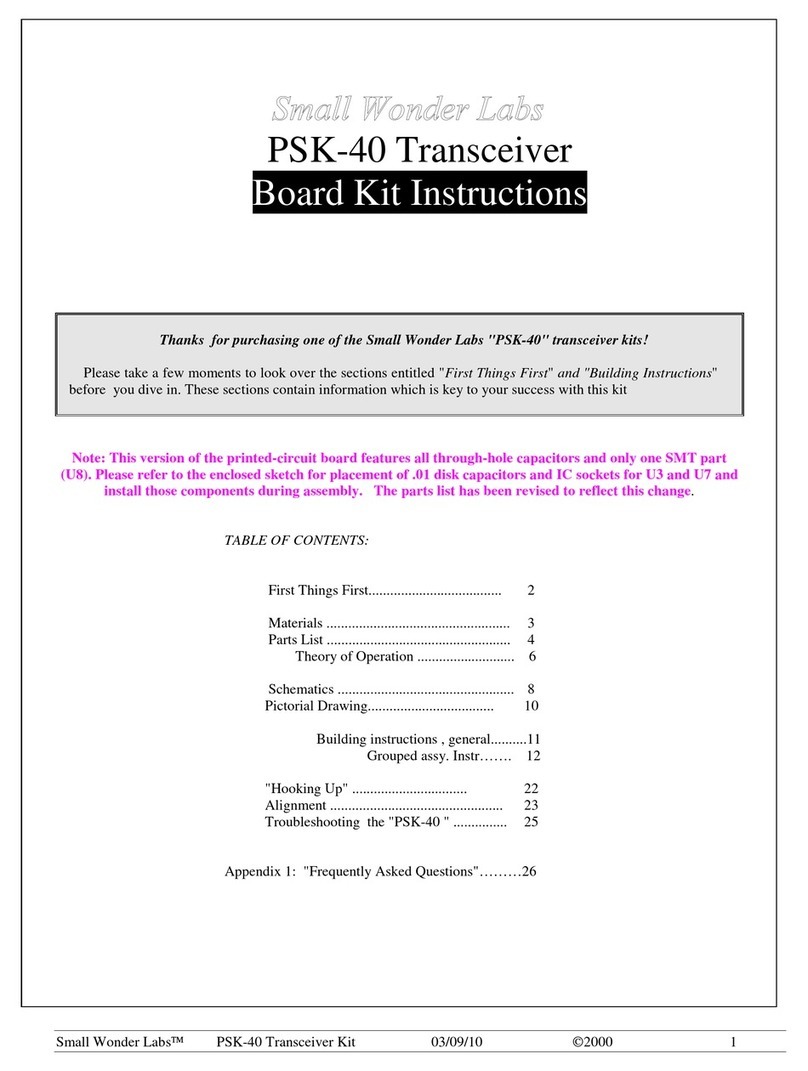
Small Wonder Labs
Small Wonder Labs PSK-40 User manual
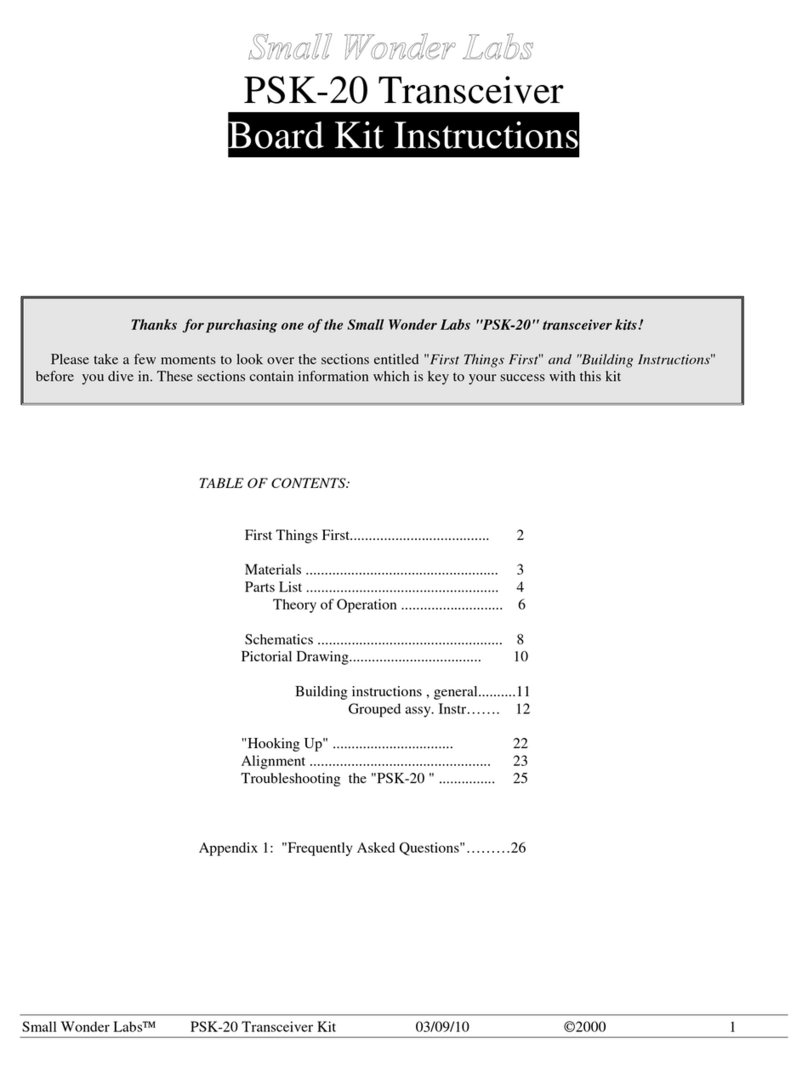
Small Wonder Labs
Small Wonder Labs PSK-20 User manual
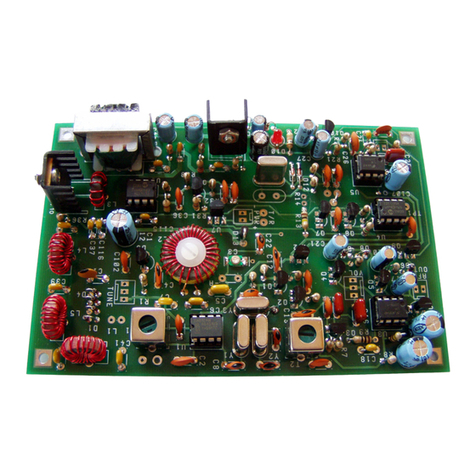
Small Wonder Labs
Small Wonder Labs Retro-40 User manual
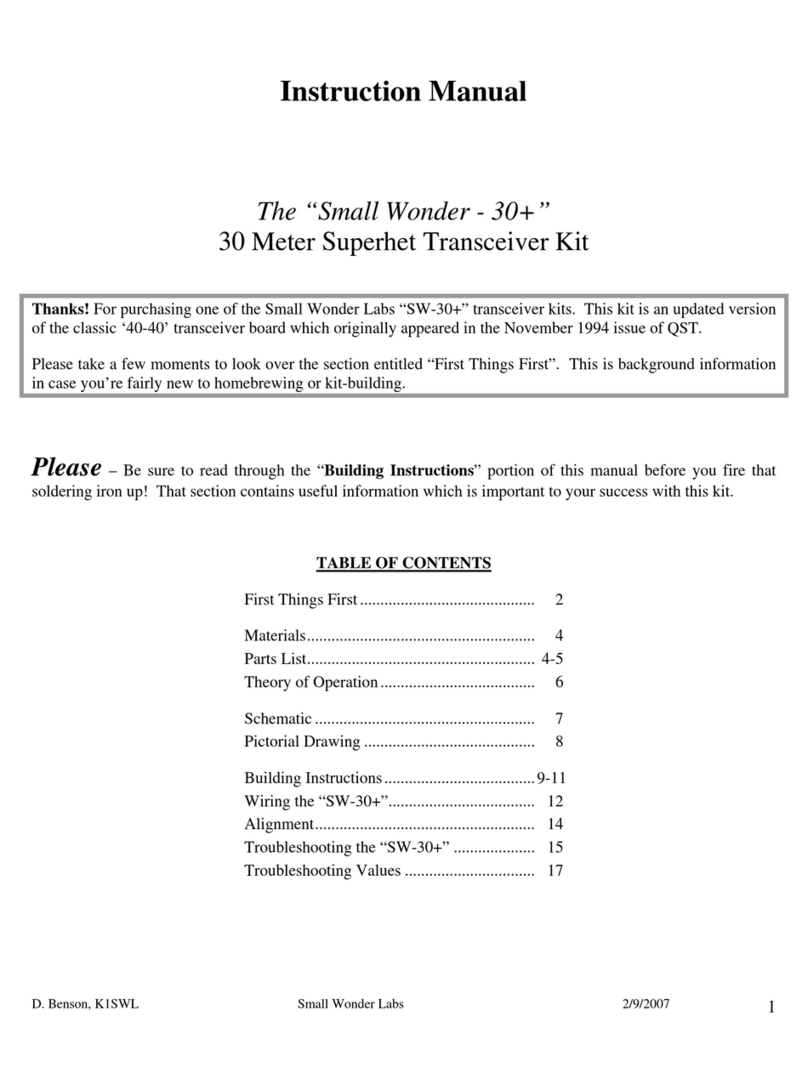
Small Wonder Labs
Small Wonder Labs SW-30+ User manual
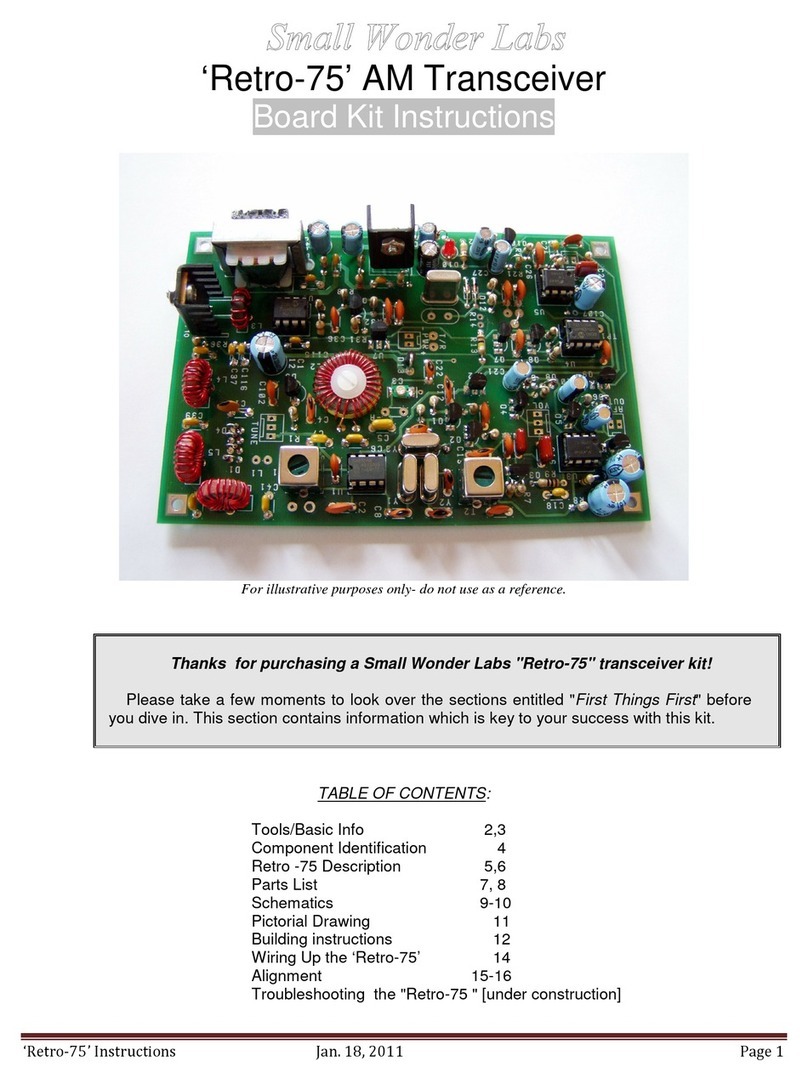
Small Wonder Labs
Small Wonder Labs Retro-75 User manual
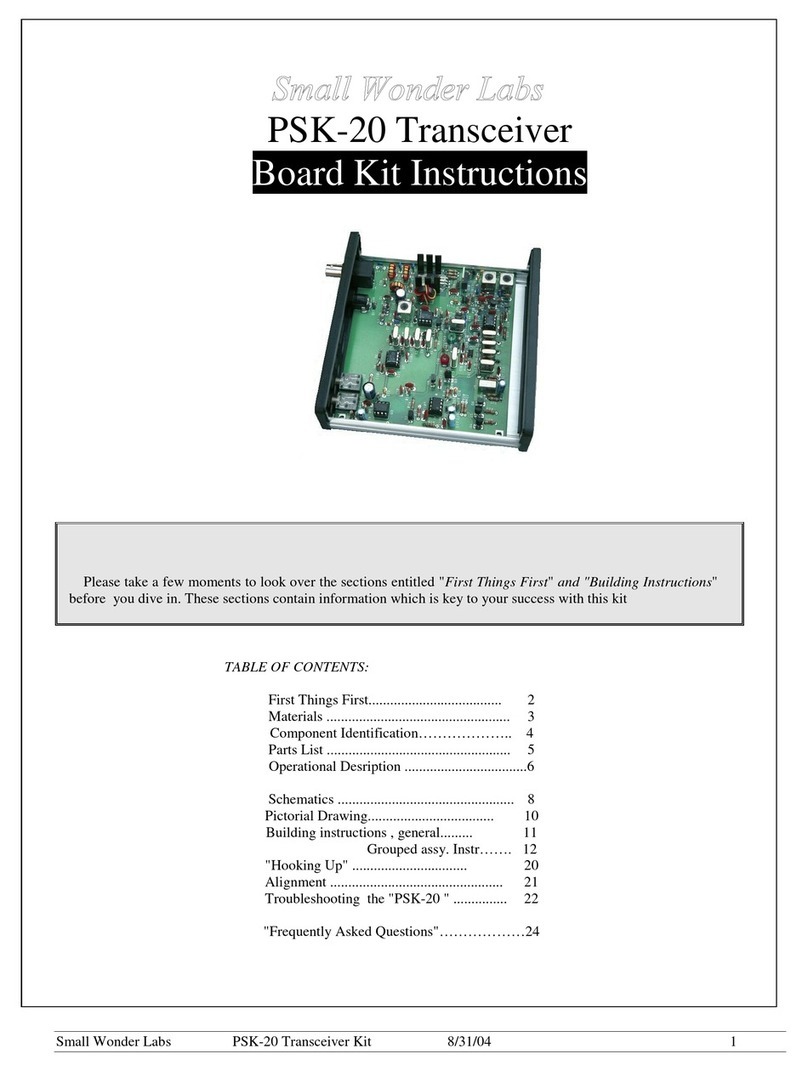
Small Wonder Labs
Small Wonder Labs PSK-20 User manual
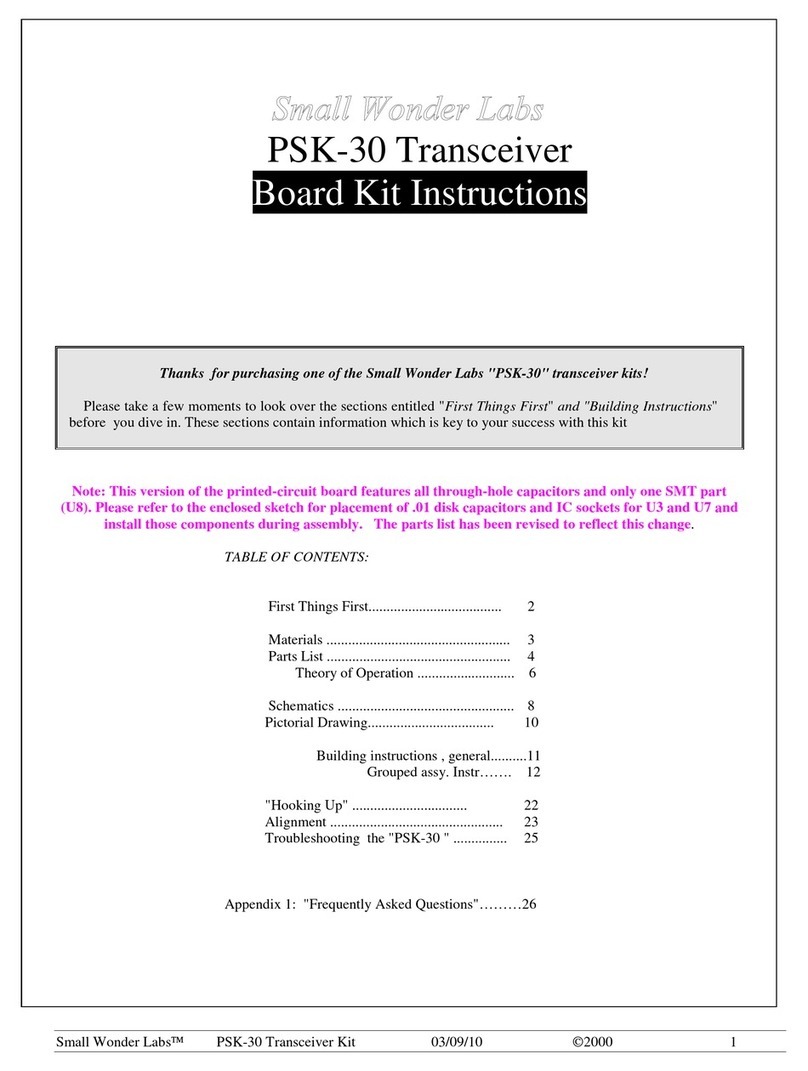
Small Wonder Labs
Small Wonder Labs PSK-30 Manual

